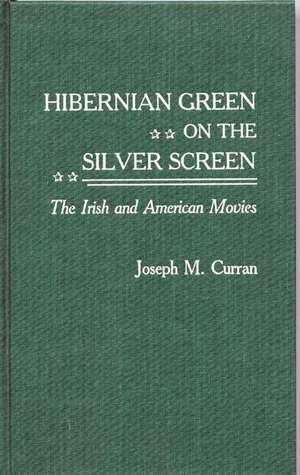Hibernian Green on the Silver Screen: The Irish and American Movies: Contributions in Sociology,, cartea 23
Autor Joseph M. Curranen Limba Engleză Hardback – 3 mai 1989
This study explores the relationship of an ethnic group of vital importance in America's history--the Irish--and a preeminently American art form and business--the movies. Curran maintains that movies reflected and influenced their viewers' perceptions of the Irish and that both the movies and the Irish who made them facilitated the assimilation of the Irish ethnic group into American society. The initial chapter traces the history of Irish immigration to America, concentrating on the experiences of Irish Catholic immigrants to the United States during the second half of the nineteenth century. Irish-American involvement in the movie industry dates from its beginnings in the Nickelodeon Era at the turn of the twentieth century. From that time until their replacement by sound movies around 1930, silent films helped to popularize the Irish ethnic group while simultaneously transmitting assimilationist values to its members and other ethnic minorities.
Three chapters are devoted to the 1930-1960 period--Hollywood's heyday when American motion pictures attained technical maturity and enjoyed their greatest popular influence. During this period the Irish made their biggest gains both in the movies and the nation, as screen personae such as the Irish priest, antihero, and Irish All-American entered popular culture. James Cagney, Spencer Tracy, John Ford, Gene Kelly, and Grace Kelly are just a few of the Irish-American movie greats discussed. Irish success in the movies facilitated and mirrored their rise in America and helped to transform them from outsiders to a no-longer readily distinguishable ethnic minority. The culmination of this transformation and integration was the election of the first Irish Catholic President of the United States, John F. Kennedy. A final chapter discusses the post-1960 era. The volume is illustrated with stills from some of America's most popular and memorable movies, including such favorites and prototypically Irish films as "Angels with Dirty Faces," "Going My Way," "The Fighting 69th," "The Informer," "The Quiet Man," "A Tree Grows in Brooklyn," and "On the Waterfront," among others. As well as having great nostalgic appeal for readers interested in the Irish or movies, "Hibernian Green on the Silver Screen" is an excellent text for courses in Irish Studies and American Ethnic or Film History.
Din seria Contributions in Sociology,
- 43%
 Preț: 372.68 lei
Preț: 372.68 lei - 38%
 Preț: 345.67 lei
Preț: 345.67 lei - 42%
 Preț: 300.12 lei
Preț: 300.12 lei - 33%
 Preț: 320.42 lei
Preț: 320.42 lei - 38%
 Preț: 438.84 lei
Preț: 438.84 lei - 35%
 Preț: 461.95 lei
Preț: 461.95 lei - 28%
 Preț: 459.84 lei
Preț: 459.84 lei - 51%
 Preț: 304.19 lei
Preț: 304.19 lei - 26%
 Preț: 354.40 lei
Preț: 354.40 lei - 51%
 Preț: 346.97 lei
Preț: 346.97 lei - 38%
 Preț: 441.04 lei
Preț: 441.04 lei - 38%
 Preț: 344.22 lei
Preț: 344.22 lei - 35%
 Preț: 463.81 lei
Preț: 463.81 lei - 35%
 Preț: 362.53 lei
Preț: 362.53 lei - 28%
 Preț: 498.06 lei
Preț: 498.06 lei - 27%
 Preț: 345.67 lei
Preț: 345.67 lei - 38%
 Preț: 437.40 lei
Preț: 437.40 lei - 24%
 Preț: 462.37 lei
Preț: 462.37 lei - 42%
 Preț: 325.94 lei
Preț: 325.94 lei - 27%
 Preț: 438.67 lei
Preț: 438.67 lei - 38%
 Preț: 344.31 lei
Preț: 344.31 lei - 38%
 Preț: 438.59 lei
Preț: 438.59 lei - 40%
 Preț: 556.46 lei
Preț: 556.46 lei - 35%
 Preț: 362.62 lei
Preț: 362.62 lei - 38%
 Preț: 435.12 lei
Preț: 435.12 lei - 38%
 Preț: 438.07 lei
Preț: 438.07 lei - 51%
 Preț: 252.48 lei
Preț: 252.48 lei - 27%
 Preț: 441.29 lei
Preț: 441.29 lei - 27%
 Preț: 438.76 lei
Preț: 438.76 lei - 18%
 Preț: 354.59 lei
Preț: 354.59 lei - 38%
 Preț: 440.11 lei
Preț: 440.11 lei - 27%
 Preț: 438.24 lei
Preț: 438.24 lei - 38%
 Preț: 344.98 lei
Preț: 344.98 lei - 26%
 Preț: 354.40 lei
Preț: 354.40 lei - 27%
 Preț: 443.91 lei
Preț: 443.91 lei - 28%
 Preț: 344.31 lei
Preț: 344.31 lei - 38%
 Preț: 438.84 lei
Preț: 438.84 lei - 38%
 Preț: 436.57 lei
Preț: 436.57 lei - 38%
 Preț: 343.31 lei
Preț: 343.31 lei
Preț: 344.90 lei
Preț vechi: 555.84 lei
-38% Nou
66.00€ • 71.67$ • 55.44£
Carte tipărită la comandă
Livrare economică 22 aprilie-06 mai
Specificații
ISBN-10: 0313264910
Pagini: 172
Dimensiuni: 140 x 216 x 16 mm
Greutate: 0.4 kg
Editura: Greenwood Press
Colecția Praeger
Seria Contributions in Sociology,
Descriere
Three chapters are devoted to the 1930-1960 period--Hollywood's heyday when American motion pictures attained technical maturity and enjoyed their greatest popular influence. During this period the Irish made their biggest gains both in the movies and the nation, as screen personae such as the Irish priest, antihero, and Irish All-American entered popular culture. James Cagney, Spencer Tracy, John Ford, Gene Kelly, and Grace Kelly are just a few of the Irish-American movie greats discussed. Irish success in the movies facilitated and mirrored their rise in America and helped to transform them from outsiders to a no-longer readily distinguishable ethnic minority. The culmination of this transformation and integration was the election of the first Irish Catholic President of the United States, John F. Kennedy. A final chapter discusses the post-1960 era. The volume is illustrated with stills from some of America's most popular and memorable movies, including such favorites and prototypically Irish films as Angels with Dirty FaceS≪/i>, Going My Way, The Fighting 69th, The Informer, The Quiet Man, A Tree Grows in Brooklyn, and On the Waterfront, among others. As well as having great nostalgic appeal for readers interested in the Irish or movies, Hibernian Green on the Silver Screen is an excellent text for courses in Irish Studies and American Ethnic or Film History.
Notă biografică
JOSEPH M. CURRAN is a Professor of History at Le Moyne College in Syracuse, New York. He is the author of The Birth of the Irish Free State, 1921-1923, and has published articles in Historian, Irish University Review (Dublin), and America.










